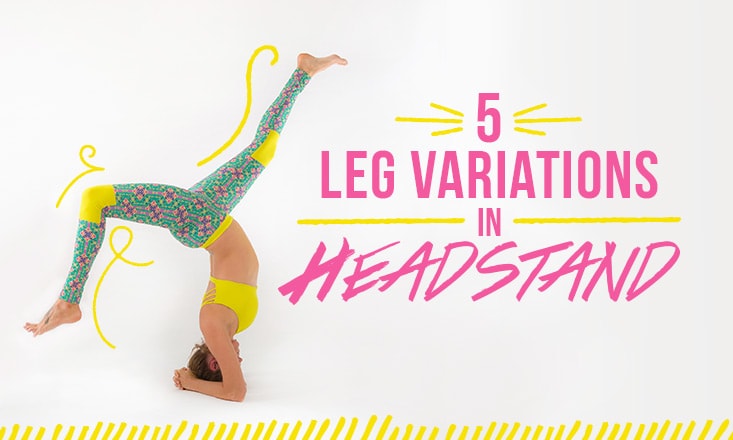If you’re comfortable in Headstand away from the wall—and I mean really comfortable—and can hold Sirsasana I (straight up and down) for at least 5 minutes, you’re ready to start playing with some variations.
If you’re not comfortable in Headstand yet, you could build up your strength and flexibility by taking part in this free 30 Day Yoga Challenge! Standing on your head is not a beginners pose, The 30 Day challenge will build you up gently, so you gain confidence before you move on to more challenging poses.
In “Light on Yoga,” B.K.S. Iyengar presents the Sirsasana Cycle, a variety of movements that can be practiced after staying in Salamba Sirsasana I for 5 minutes; and there are seven Headstand variations involving different arm positions in the second Ashtanga series.
However, the Headstand party doesn’t end there. Instagram will show you that there’s an endless number of leg and arm variations to test not only your balance, strength, and flexibility, but also your proprioception, or the ability to sense your body in space.
Going upside down can be disorienting enough (especially those new to inversions)—trying to organize your legs while you’re upside down is a whole new ballgame.
Students just learning Headstand: make sure you’re under the guidance of an experienced teacher, and for those still becoming comfortable in Headstand, try doing the pose in the corner of a room to work on balancing away from the wall.
Now, for those of you who are ready for a new challenge, here are five of my favorite leg variations in Salamba Sirsasana I.
1. Wide-Legged Headstand
 Credit: Nir Livni Photography
Credit: Nir Livni PhotographyThere are a couple of ways to get into this leg variation. Once you’ve found stability in your vertical Headstand, begin to open your legs. With the legs wide apart, begin to tilt your pelvis forward (and firm your core!), turning the tops of your thighs and toes down to the floor and the backs of your legs up.
Press out through your heels and up through your inner thighs for balance.
You could start with your feet apart on the floor and lift the legs simultaneously into Wide-Legged. Play with tilting your pelvis forward and back and lifting and lowering the legs. Once you’re really comfortable, it’s fun to do core work in this variation, tapping your toes down and lifting them back up.
2. Baddha Konasana in Headstand
 Credit: Nir Livni Photography
Credit: Nir Livni PhotographyThis variation is fun to play with in combination with Wide-Legged Headstand. From wide legs, bend your knees and bring the soles of your feet together: this is a lot harder than it sounds. Press your feet together and open your knees wide to the sides while you try to keep your toes pointing straight up.
3. Eagle Legs in Headstand
 Credit: Nir Livni Photography
Credit: Nir Livni PhotographyFrom Sirsasana I, begin to bend your legs bringing your knees forward and slightly bottom back (like you’re sitting in a little chair). Cross one thigh over the other and wrap the leg around the other like you would do in Eagle Pose.
Play with lowering the knees and bringing your thighs parallel to the floor, tilting your pelvis forward, or try lifting your knees up toward the ceiling so that the soles of your feet are facing the same direction as your back.
4. Twisting Splits in Headstand
 Credit: Nir Livni Photography
Credit: Nir Livni PhotographyFrom Sirsasana I, open your legs apart from front to back and press out through the heels coming into the shape of the splits. If your left leg is in front, you’re going to start twisting your torso to the right; however, your shoulders can’t turn with you.
To stabilize through the shoulder girdle, strongly pull back through the opposite shoulder; so that if your left leg is in front and you’re twisting to the right, you must pull your left shoulder back strongly.
5. Lotus Legs in Headstand
 Credit: Nir Livni Photography
Credit: Nir Livni PhotographyYou think folding into Lotus is tough on the ground, try doing it upside down! I highly suggest becoming pretty comfortable in the seated posture before trying it in Headstand, but once you’re upside down it’s pretty much the same folding of the legs—but without the use of your hands.
From Sirsasana I, bend one knee out to the side and bring the top of the foot into the opposite hip crease. Then, bring your leg and knee forward and bottom slightly back as you bend the second knee out to the side.
Cross over the shin and nestle your second foot into Lotus Pose, which may take a few attempts.
There you have it: five different Headstand leg variations! Try them out for yourself and let me know what happens, yogis!
Image credit: Nir Livni Photography / Yogini: Meagan McCrary


